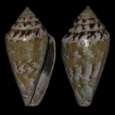The phylum Mollusca is the second largest in
the animal kingdom. Most of the mollusca species are marine; they are
represented in fresh water only by snails and mussels, and on land by
snails and slugs. Their basic pattern of construction has four
divisions: the head with the mouth, the dorsal ventral sack, the
ventral foot, and the mantle. The respiratory organs are contained in
the mantle cavity situated between the mantle and the visceral sack.
There is no internal skeleton. The snails (Gastropoda) represent the largest
section of the Mollusca. The
mantle, in this class, generally secretes a spiral or bowl-shaped shell
made up of two or three layers: the outer uncalcified periostracum, the
middle layer made up of the ostracum consisting of several layers of
calcite or arragonite, and in some species this is followed by a layer
of mother-of-pearl.
 Shells belonging to the families Turridae and Conidae have a hollow tooth which
is connected to a poison gland. Shells belonging to the Turridae have longish oval or
spindle-shaped shells curved in along the whorl seams; those belonging
to the Conidae are conical short spiral with high terminal whorls, a
long narrow aperture and a correspondingly shaped operculum. These
toxic stinging shells are found in the warm waters of the Indo-Pacific,
Australia and New Zealand, Southern California, and the Mediterranean.
Shells belonging to the families Turridae and Conidae have a hollow tooth which
is connected to a poison gland. Shells belonging to the Turridae have longish oval or
spindle-shaped shells curved in along the whorl seams; those belonging
to the Conidae are conical short spiral with high terminal whorls, a
long narrow aperture and a correspondingly shaped operculum. These
toxic stinging shells are found in the warm waters of the Indo-Pacific,
Australia and New Zealand, Southern California, and the Mediterranean.  The different species in these families can fire a
barbed harpoon like device from a slit in their shell to obtain food
and to protect against predators. The cone shell uses its sting to
secrete a neurotoxin that competes for acetylcholine in the body. Their
food consists of worms, mollusks or fish. The fish feeding variety of
cones are the most dangerous to humans. These can cause death within 15
minutes. The Mediterranean species Fusiturris
similis and Conus
mediterraneus are not as dangerous as those found in the
tropics, but can still cause collapse.
The different species in these families can fire a
barbed harpoon like device from a slit in their shell to obtain food
and to protect against predators. The cone shell uses its sting to
secrete a neurotoxin that competes for acetylcholine in the body. Their
food consists of worms, mollusks or fish. The fish feeding variety of
cones are the most dangerous to humans. These can cause death within 15
minutes. The Mediterranean species Fusiturris
similis and Conus
mediterraneus are not as dangerous as those found in the
tropics, but can still cause collapse.
Another member of
the phylum Mollusca are the
octopuses or cephalopoda. These have a parrot-like beak and can inflict
a painful bite. These bites are rarely serious and should be managed as
lacerations.
Since most Mollusca
species are filter-feeders, the edible species can bear pathological
organisms acquired from their marine environment thus contributing to
outbreaks of typhoid and infective hepatitis. They can also have high
heavy metal levels .
.
Clinical Features:
With injection
of the toxin, the injection site becomes initially very painful and
subsequently the surrounding skin becomes insensitive and bluish. The
poison may be systemically absorbed to cause a slight generalized
weakness of the body, associated with generalized numbness, tingling or
itching of the skin. With very toxic species, neurological symptoms
would be more severe leading to ataxia, breathing problems, difficult
swallowing, paralysis, coma and death.
Treatment:
The treatment of Conus stings
is largely empirical.
- For the less
toxic species:-
- As first
aid, it is essential to clean the wound thoroughly with fresh or salt
water, and to provide a strong pain-killer.
- The
affected area should be soaked in hot water or covered with a hot
compress. The water should be very hot (circa 1220 F), so
that the heat will deactivate the poison.
- For the more
toxic species:-
- continue
applying hot water for 30 minutes to an hour.
- The patient
should lie still with the stung part immobile and lower than the heart.
Tie a venous tourniquet around a stung limb two or four inches above
the sting. If the swelling reaches the band, tie another venous
tourniquet two or four inches higher up and remove the first one.
- Local
injection of epinephrine and subsequent use of neostigmine has been
suggested for the management of severe toxic species poisoning.
- Mechanical
ventilation and measures to combat shock will be needed.







 Shells belonging to the families
Shells belonging to the families  The different species in these families can fire a
barbed harpoon like device from a slit in their shell to obtain food
and to protect against predators. The cone shell uses its sting to
secrete a neurotoxin that competes for acetylcholine in the body. Their
food consists of worms, mollusks or fish. The fish feeding variety of
cones are the most dangerous to humans. These can cause death within 15
minutes. The Mediterranean species
The different species in these families can fire a
barbed harpoon like device from a slit in their shell to obtain food
and to protect against predators. The cone shell uses its sting to
secrete a neurotoxin that competes for acetylcholine in the body. Their
food consists of worms, mollusks or fish. The fish feeding variety of
cones are the most dangerous to humans. These can cause death within 15
minutes. The Mediterranean species 